Abandonment Leads to Changes in Forest Structural and Soil Organic Carbon Stocks in Moso Bamboo Forests
Abstract
1. Introduction
2. Materials and Methods
2.1. Study Area
2.2. Experimental Design and Field Sampling
2.3. Soil Analyses
2.4. Data Analysis
3. Results
3.1. Abandonment Effects on Forests Structural Characteristics
3.2. Abandonment Effects on SOC Stocks
3.3. Relationship between SOC Stocks and Environmental Variables
3.4. Depth-Dependent SOC Stock Drivers
4. Discussion
4.1. Effects of Changes in Biomass on Structural Characteristics
4.2. Effects of Biomass on SOC Stocks
4.3. Effects of Mineral Properties and TN on SOC Stocks
4.4. Implications
5. Conclusions
Author Contributions
Funding
Institutional Review Board Statement
Informed Consent Statement
Data Availability Statement
Conflicts of Interest
Appendix A
| Type of Sample Plot | Number | Average Altitude (m) | Major Understory Vegetation |
|---|---|---|---|
| CK | 13 | 128.63 | Viola verecunda, Arthraxon hispidus |
| AM-1 | 8 | 154.78 | Paederia scandens, Osmunda japonica |
| AM-2 | 9 | 119.71 | Callicarpa dichotoma, Kadsura longipedunculata, Pteridium aquilinum |
| AM-3 | 10 | 198.36 | Pteridium aquilinum, Microsorum punctatum |
| Scenarios | TP (g kg−1) | TN (g kg–1) | TC (%) |
|---|---|---|---|
| CK | 0.62 ± 0.03 | 1.03 ± 0.07 | 22.98 ± 1.44 |
| AM-1 | 0.78 ± 0.04 | 1.56 ± 0.09 | 33.11 ± 1.86 |
| AM-2 | 0.70 ± 0.06 | 1.37 ± 0.09 | 30.06 ± 1.5 |
| AM-3 | 1.04 ± 0.1 | 1.66 ± 0.04 | 34.11 ± 1.15 |
| Depth (cm) | Scenarios | PH Value | TN (g kg–1) | TP (g kg–1) | Soil Moisture (%) | Bulk Density (g cm–3) |
|---|---|---|---|---|---|---|
| 0–15 | CK | 4.93 ± 0.09 b | 1.33 ± 0.06 b | 0.38 ± 0.03 b | 18.65 ±1.04 a | 1.09 ±0.02 b |
| AM-1 | 4.97 ± 0.1 ab | 1.47 ± 0.13 b | 0.3 ± 0.13 c | 16.39 ± 2.05 a | 1.17 ± 0.02 a | |
| AM-2 | 5.09 ± 0.07 ab | 1.88 ± 0.19 a | 0.34 ± 0.03 bc | 20.27 ± 0.99 a | 1.21 ± 0.04 a | |
| AM-3 | 5.23 ± 0.07 a | 2.2 ± 0.16 a | 0.53 ± 0.02 a | 16.79 ± 1.31 a | 1.25 ± 0.03 a | |
| 15–30 | CK | 4.97 ± 0.13 b | 0.90 ± 0.14 c | 0.29 ± 0.05 b | 18.62 ±1.10 a | 1.17 ±0.03 a |
| AM-1 | 4.97 ± 0.08 b | 1.30 ±0.08 bc | 0.32 ± 0.01 b | 17.09 ± 1.73 ab | 1.21 ± 0.02 a | |
| AM-2 | 5.21 ± 0.14 b | 1.62 ± 0.19 ab | 0.34 ± 0.02 b | 18.79 ± 0.83 a | 1.21 ±0.02 a | |
| AM-3 | 5.61 ± 0.09 a | 1.89 ± 0.09 a | 0.51 ± 0.02 a | 14.26 ± 1.84 b | 1.23 ± 0.02 a |
| Depth (cm) | Scenarios | CEC (cmol kg−1) | Clay Content (%) | Fed + Ald (g kg−1) | Fep + Alp (g kg−1) | Feo + Alo (g kg−1) |
|---|---|---|---|---|---|---|
| 0–15 | CK | 21.92 ± 1.01 a | 19.19 ± 1.4 b | 2.91 ± 0.10 bc | 5.92 ± 0.46 a | 3.76 ± 0.16 b |
| AM-1 | 13.79 ± 0.75 c | 29.08 ± 0.47 a | 3.86 ± 0.32 a | 3.96 ± 0.13 b | 3.69 ± 0.22 b | |
| AM-2 | 17.18 ± 1.08 b | 27.71 ± 0.8 a | 3.41 ± 0.20 ab | 3.93 ± 0.19 b | 4.10 ± 0.18 b | |
| AM-3 | 18.63 ± 0.78 b | 26.39 ± 0.78 a | 2.67 ± 0.10 c | 2.75 ± 0.12 c | 5.00 ± 0.48 a | |
| 15–30 | CK | 19.29 ± 1.65 a | 20.64 ± 1.74 b | 2.36 ± 0.20 c | 4.72 ± 0.41 a | 4.11 ± 0.30 a |
| AM-1 | 12.90 ± 0.49 b | 30.79 ± 0.48 a | 4.23 ± 0.44 a | 5.35 ± 0.56 a | 4.65 ± 0.29 a | |
| AM-2 | 16.32 ± 0.89 ab | 29.29 ± 0.69 a | 3.36 ± 0.19 b | 4.47 ± 0.21 a | 4.65 ± 0.17 a | |
| AM-3 | 16.80 ± 0.83 a | 27.47 ± 0.58 a | 2.34 ± 0.08 c | 2.57 ± 0.14 b | 4.55 ± 0.14 a |
References
- van Groenigen, K.J.; Osenberg, C.W.; Hungate, B.A. Increased soil emissions of potent greenhouse gases under increased atmospheric CO2. Nature 2011, 475, 214–216. [Google Scholar] [CrossRef] [PubMed]
- Mayer, M.; Prescott, C.E.; Abaker, W.E.A.; Augusto, L.; Cécillon, L.; Ferreira, G.W.D.; James, J.; Jandl, R.; Katzensteiner, K.; Laclau, J.P.; et al. Tamm review: Influenceof forest management activities on soil organic carbon stocks: A knowledge synthesis. For. Ecol. Manag. 2020, 466, 118127. [Google Scholar] [CrossRef]
- Sanderman, J.; Hengl, T.; Fiske, G.J. Soil carbon debt of 12,000 years of human land use. Proc. Natl. Acad. Sci. USA 2017, 114, 9575–9580. [Google Scholar] [CrossRef] [PubMed]
- Barlow, J.; França, F.; Gardner, T.A.; Hicks, C.C.; Lennox, G.D.; Berenguer, E.; Castello, L.; Economo, E.P.; Ferreira, J.; Guénard, B.; et al. The future of hyperdiverse tropical ecosystems. Nature 2018, 559, 517–526. [Google Scholar] [CrossRef] [PubMed]
- Li, P.; Zhou, G.; Du, H.; Lu, D.; Mo, L.; Xu, X.; Shi, Y.; Zhou, Y. Current and potential carbon stocks in Moso bamboo forests in China. J. Environ. Manag. 2015, 156, 89–96. [Google Scholar] [CrossRef]
- Yin, J.; Ge, Z.; Deng, X.; Shi, Y.; Xu, L.; Zhou, G.; Ye, Y.; Zhang, F.; Zhou, Y.; Li, C.; et al. Abandonment lead to structural degradation and changes in carbon allocation patterns in Moso bamboo forests. For. Ecol. Manag. 2019, 449, 117449. [Google Scholar] [CrossRef]
- Deng, X.; Yin, J.; Xu, L.; Shi, Y.; Zhou, G.; Li, Y.; Chen, G.; Ye, Y.; Zhang, F.; Zhou, Y.; et al. Effects of abandonment management on soil C and N pools in Moso bamboo forests. Sci. Total Environ. 2020, 729, 138949. [Google Scholar] [CrossRef] [PubMed]
- Gren, I.M.; Zeleke, A.A. Policy design for forest carbon sequestration: A review of the literature. For. Policy Econ. 2016, 70, 128–136. [Google Scholar] [CrossRef]
- Xu, L.; Shi, Y.J.; Zhou, G.M.; Xu, X.J.; Liu, E.B.; Zhou, Y.F.; Zhang, F.; Li, C.; Fang, H.Y.; Chen, L. Structural development and carbon dynamics of moso bamboo forests in Zhejiang Province, China. For. Ecol Manag. 2018, 409, 479–488. [Google Scholar] [CrossRef]
- Wiesmeier, M.; Munro, S.; Barthold, F.; Steffens, M.; Schad, P.; Kogel-Knabner, I. Carbon storage capacity of semi-arid grassland soils and sequestration potentials in northern China. Glob. Chang. Biol. 2015, 21, 3836–3845. [Google Scholar] [CrossRef] [PubMed]
- Bradford, M.A.; Warren, R.J.; Baldrian, P.; Crowther, T.W.; Maynard, D.S.; Oldfield, E.E.; Wieder, W.R.; Wood, S.A.; King, J.R. Climate fails to predict wood decomposition at regional scales. Nat. Clim. Chang. 2014, 4, 625–630. [Google Scholar] [CrossRef]
- Ge, J.; Xu, W.; Xiong, G.; Zhao, C.; Li, J.; Liu, Q.; Tang, Z.; Xie, Z. Depth-Dependent Controls Over Soil Organic Carbon Stock across Chinese Shrublands. Ecosystems 2023, 26, 277–289. [Google Scholar] [CrossRef]
- Wu, Y.; Guo, Z.; Li, Z.; Liang, M.; Tang, Y.; Zhang, J.; Miao, B.; Wang, L.; Liang, C. The main driver of soil organic carbon differs greatly between topsoil and subsoil in a grazing steppe. Ecol. Evol. 2022, 12, 9182. [Google Scholar] [CrossRef] [PubMed]
- Yu, W.; Weintraub, S.R.; Hall, S.J. Climatic and Geochemical Controls on Soil Carbon at the Continental Scale: Interactions and Thresholds. Glob. Biogeochem. Cycles 2021, 35, e2020GB006781. [Google Scholar] [CrossRef]
- Xu, Y.; Ge, X.; Gao, G.; Yang, Y.; Hu, Y.; Li, Z.; Zhou, B. Divergent contribution of microbial- and plant-derived carbon to soil organic carbon in Moso bamboo forests left unmanaged. Catena 2023, 233, 107481. [Google Scholar] [CrossRef]
- Xu, Y.; Ge, X.; Gao, G.; Yang, Y.; Hu, Y.; Li, Z.; Zhou, B. Microbial pathways driving stable soil organic carbon change in abandoned Moso bamboo forests in southeast China. J. Environ. Manag. 2023, 345, 118890. [Google Scholar] [CrossRef] [PubMed]
- He, M.; Fang, K.; Chen, L.; Feng, X.; Qin, S.; Kou, D.; He, H.; Liang, C.; Yang, Y. Depth-dependent drivers of soil microbial necromass carbon across Tibetan alpine grasslands. Glob. Chang. Biol. 2021, 28, 936–949. [Google Scholar] [CrossRef] [PubMed]
- Inoue, A.; Sato, M.; Shima, H. Maximum size-density relationship in bamboo forests: Case study of Phyllostachys pubescens forests in Japan. For. Ecol. Manag. 2018, 425, 138–144. [Google Scholar] [CrossRef]
- Sainju, U.; Jabro, J.; Stevens, W. Soil carbon dioxide emission and carbon content as affected by irrigation, tillage, cropping system, and nitrogen fertilization. J. Environ. Qual. 2008, 37, 98–106. [Google Scholar] [CrossRef] [PubMed]
- Shvidenko, A.; Nilsson, S. A synthesis of the impact of Russian forests on the global carbon budget for 1961–1998. Tellus B Chem. Phys. Meteorol. 2003, 55, 391–415. [Google Scholar] [CrossRef][Green Version]
- Liu, Y.; van Dijk, A.I.J.M.; de Jeu, R.A.M.; Canadell, J.G.; McCabe, M.F.; Evans, J.P.; Wang, G. Recent reversal in loss of global terrestrial biomass. Nat. Clim. Chang. 2015, 5, 470–474. [Google Scholar] [CrossRef]
- Liang, C.; Schimel, J.P.; Jastrow, J.D. The importance of anabolism in microbial control over soil carbon storage. Nat. Microbiol. 2017, 2, 17105. [Google Scholar] [CrossRef] [PubMed]
- Wang, B.; An, S.; Liang, C.; Liu, Y.; Kuzyakov, Y. Microbial necromass as the source of soil organic carbon in global ecosystems. Soil Biol. Biochem. 2021, 162, 108422. [Google Scholar] [CrossRef]
- Zhang, Q.; Feng, J.; Li, J.; Huang, C.; Shen, Y.; Cheng, W.; Zhu, B. A distinct sensitivity to priming effect between labile and stable soil organic carbon. New Phytol. 2022, 37, 88–99. [Google Scholar] [CrossRef] [PubMed]
- Chen, L.; Fang, K.; Wei, B.; Qin, S.; Feng, X.; Hu, T.; Ji, C.; Yang, Y. Soil carbon persistence governed by plant input and mineral protection at regional and global scales. Ecol. Lett. 2021, 24, 1018–1028. [Google Scholar] [CrossRef]
- Wang, Y.; Guo, Y.; Wang, X.; Song, C.; Song, Y.; Liu, Z.; Wang, S.; Gao, S.; Ma, G. Mineral protection controls soil organic carbon stability in permafrost wetlands. Sci. Total Environ. 2023, 869, 161864. [Google Scholar] [CrossRef] [PubMed]
- Johnson, C.E. Cation exchange properties of acid forest soils of the northeastern USA. Eur. J. Soil Sci. 2002, 53, 271–282. [Google Scholar] [CrossRef]
- Liu, L.; Zhang, T.; Gilliam, F.S.; Gundersen, P.; Zhang, W.; Chen, H.; Mo, J.M. Interactive effects of nitrogen and phosphorus on soil microbial communities in a tropical forest. PLoS ONE 2013, 8, e61188. [Google Scholar] [CrossRef] [PubMed]
- Evans, C.D.; Jones, T.G.; Burden, A.; Ostle, N.; Zieliński, P.; Cooper, M.D.A.; Peacock, M.; Clark, J.M.; Oulehle, F.; Cooper, D.; et al. Acidity controls on dissolved organic carbon mobility in organic soils. Glob. Chang. Biol. 2012, 18, 3317–3331. [Google Scholar] [CrossRef]
- Jiang, J.; Wang, Y.; Yu, M.; Cao, N.; Yan, J. Soil organic matter is important for acid buffering and reducing aluminum leaching from acidic forest soils. Chem. Geol. 2018, 501, 86–94. [Google Scholar] [CrossRef]
- Keiluweit, M.; Bougoure, J.J.; Nico, P.S.; Pett-Ridge, J.; Weber, P.K.; Kleber, M. Mineral protection of soil carbon counteracted by root exudates. Nat. Clim. Chang. 2015, 5, 588–595. [Google Scholar] [CrossRef]
- Yang, J.; Zhang, X.; Bourg, I.; Stone, H. 4D imaging reveals mechanisms of clay-carbon protection and release. Nat. Commun. 2021, 12, 622. [Google Scholar] [CrossRef]
- Steenwerth, K.L.; Drenovsky, R.E.; Lambert, J.J.; Kluepfel, D.A.; Scow, K.M.; Smart, D.R. Soil morphology, depth and grapevine root frequency influence microbial communities in a Pinot noir vineyard. Soil Biol. Biochem. 2008, 40, 1330–1340. [Google Scholar] [CrossRef]
- Kleber, M.; Eusterhues, K.M.; Keiluweit, M.; Mikutta, C.; Nico, P.S. Mineral-organic associations: Formation, properties, and relevance in soil environments. Adv. Agron. 2015, 130, 1–140. [Google Scholar] [CrossRef]
- Mo, J.; Zhang, W.; Zhu, W.; Gundersen, P.; Fang, Y.; Li, D.; Wang, H. Nitrogen addition reduces soil respiration in a mature tropical forest in southern China. Glob. Chang. Biol. 2008, 14, 403–412. [Google Scholar] [CrossRef]
- Huang, Y.; Li, Y.; Xiao, Y.; Wenigmann, K.O.; Zhou, G.; Zhang, D.; Wenigmann, M.; Tang, X.; Liu, J. Controls of litter quality on the carbon sink in soils through partitioning the products of decomposing litter in a forest succession series in South China. For. Ecol. Manag. 2011, 261, 1170–1177. [Google Scholar] [CrossRef]
- Bai, T.; Wang, P.; Qiu, Y.; Zhang, Y.; Hu, S. Nitrogen availability mediates soil carbon cycling response to climate warming: A meta-analysis. Glob. Chang. Biol. 2023, 29, 2608–2626. [Google Scholar] [CrossRef]
- Jia, J.; Cao, Z.; Liu, C.; Zhang, Z.; Lin, L.; Wang, Y.; Haghipour, N.; Wacker, L.; Bao, H.; Dittmar, T.; et al. Climate warming alters subsoil but not topsoil carbon dynamics in alpine grassland. Glob. Chang. Biol. 2019, 25, 4383–4393. [Google Scholar] [CrossRef] [PubMed]
- Eze, S.; Magilton, M.; Magnone, D.; Varga, S.; Gould, I.; Mercer, T.G.; Goddard, M.R. Meta-analysis of global soil data identifies robust indicators for short-term changes in soil organic carbon stock following land use change. Sci. Total Environ. 2023, 860, 160484. [Google Scholar] [CrossRef] [PubMed]
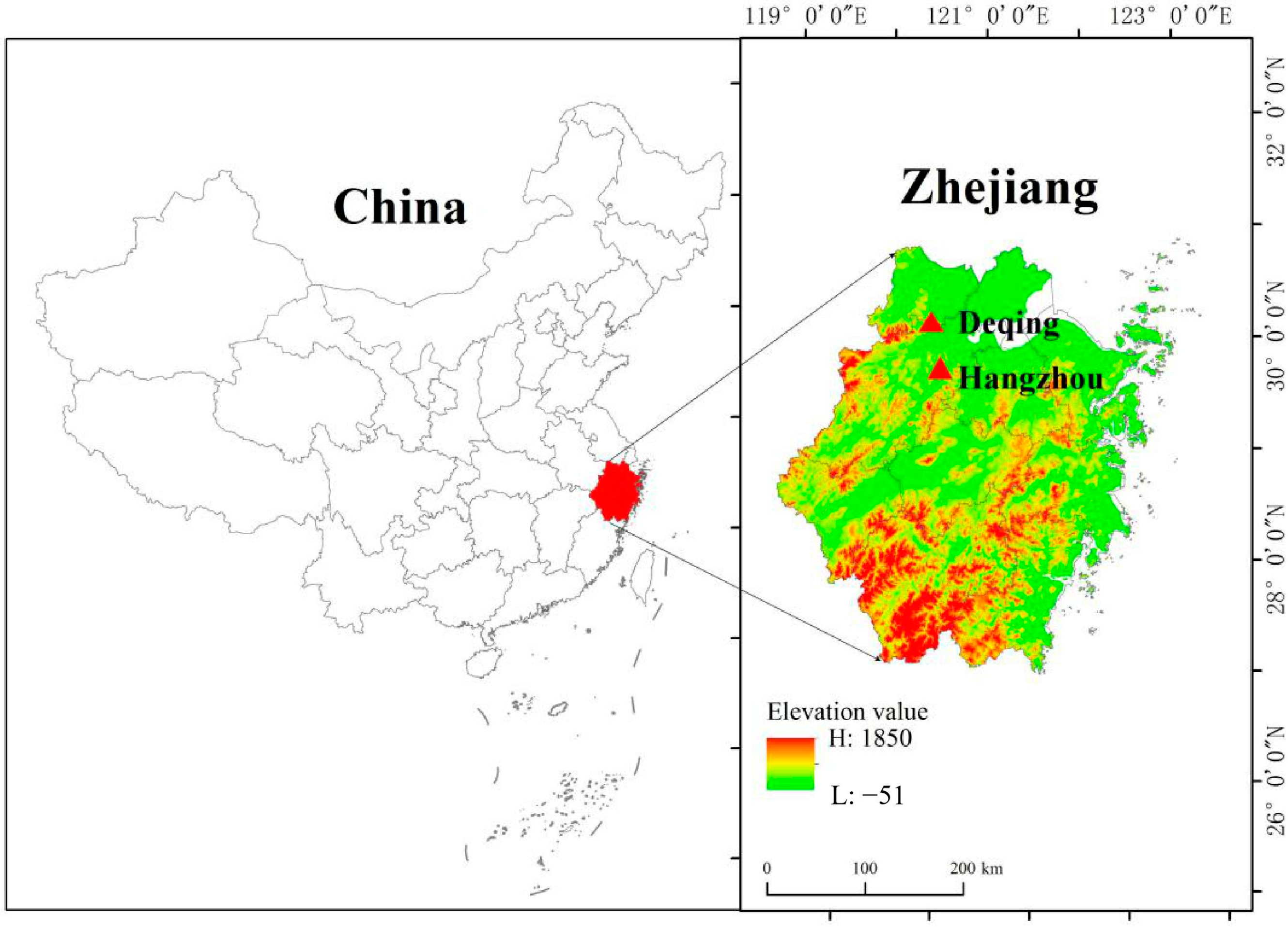


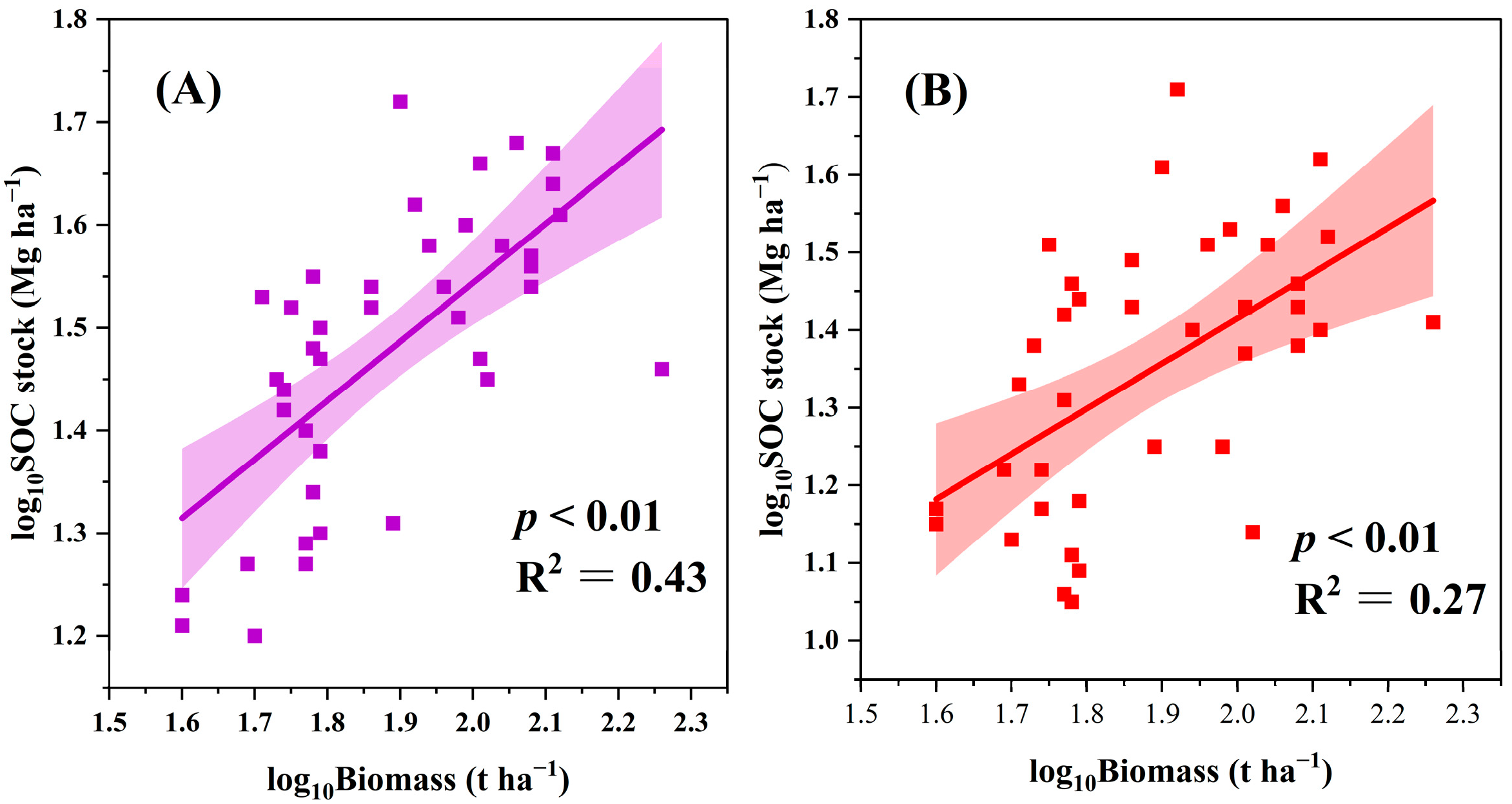
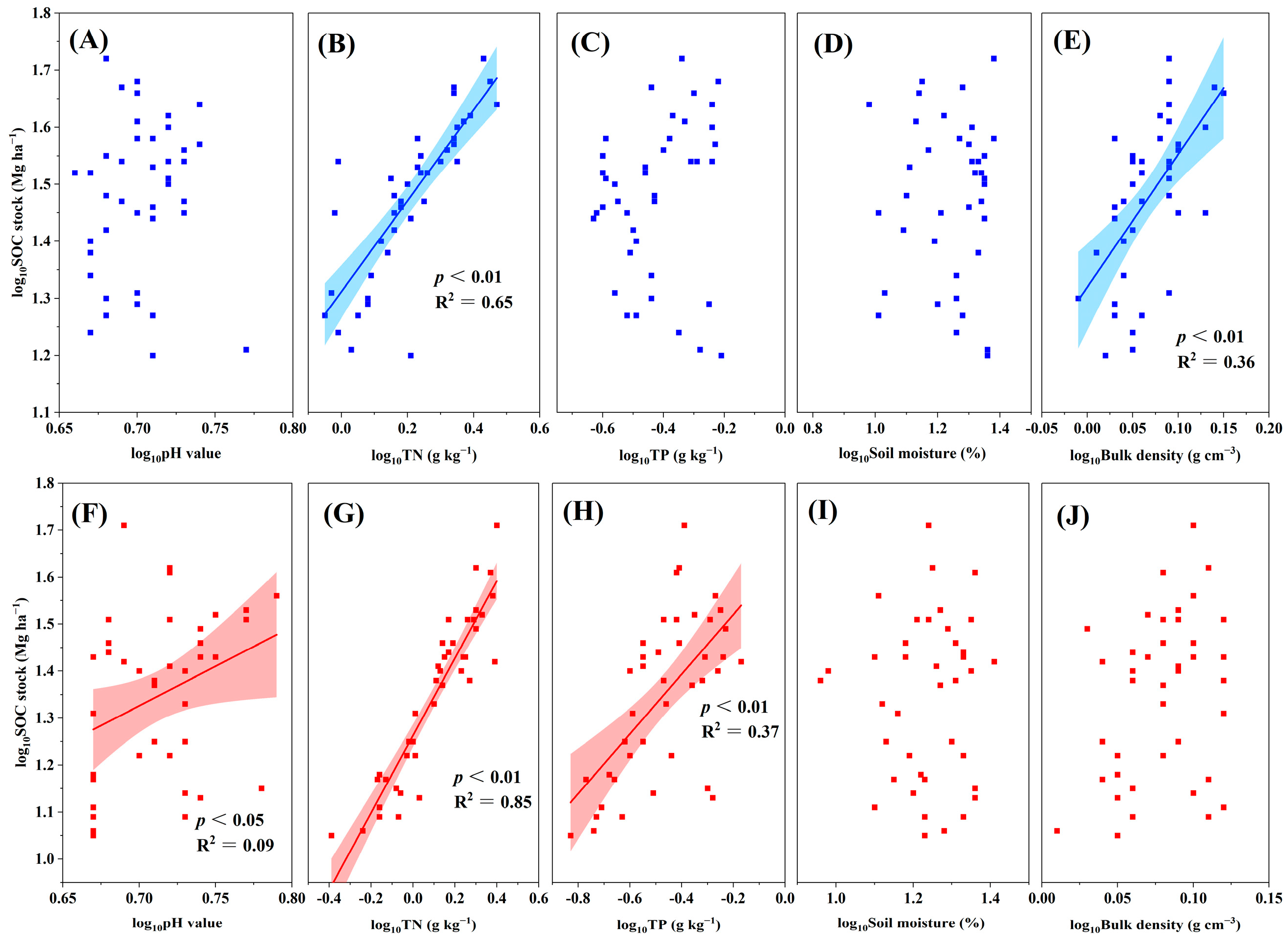
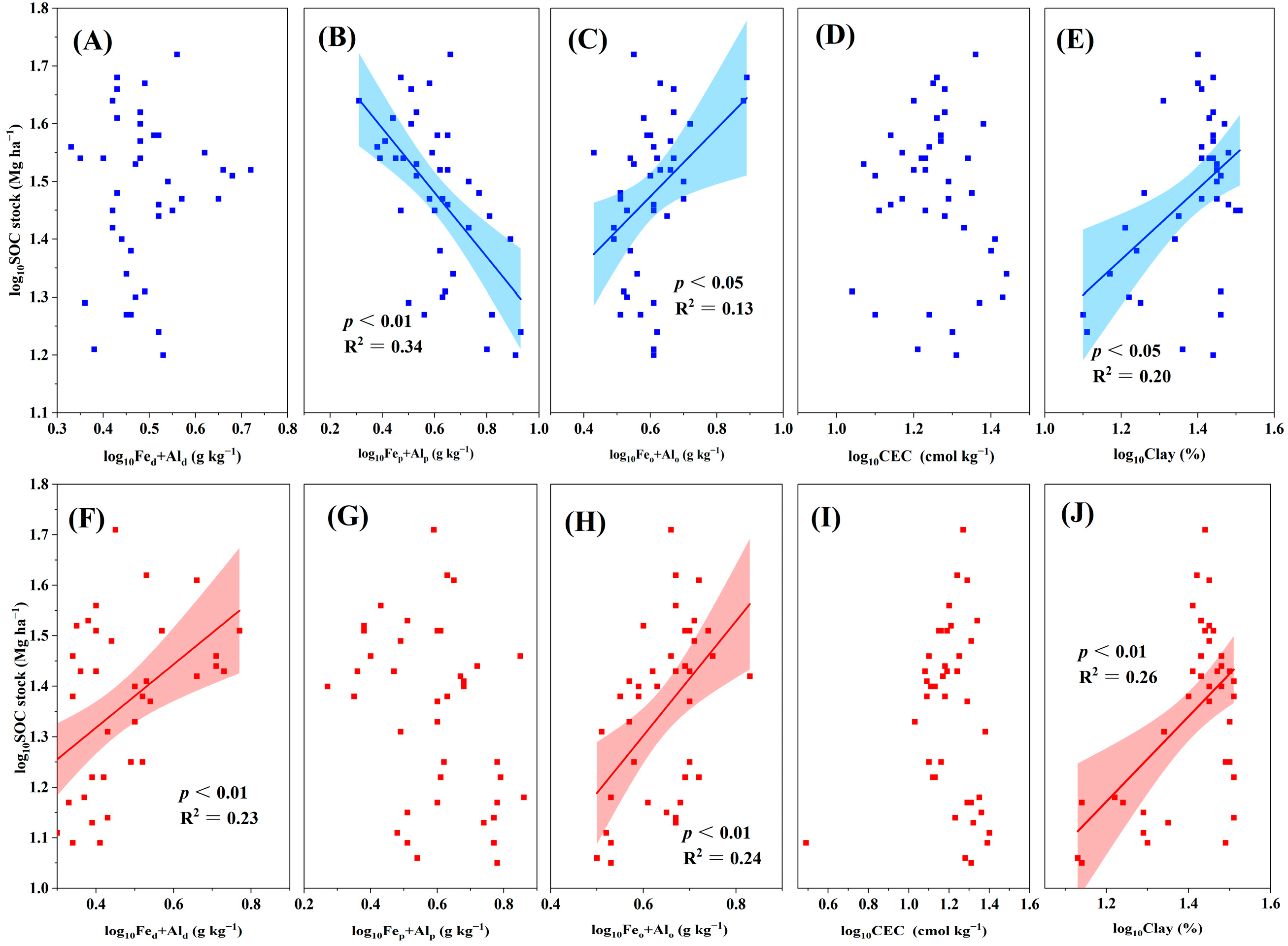
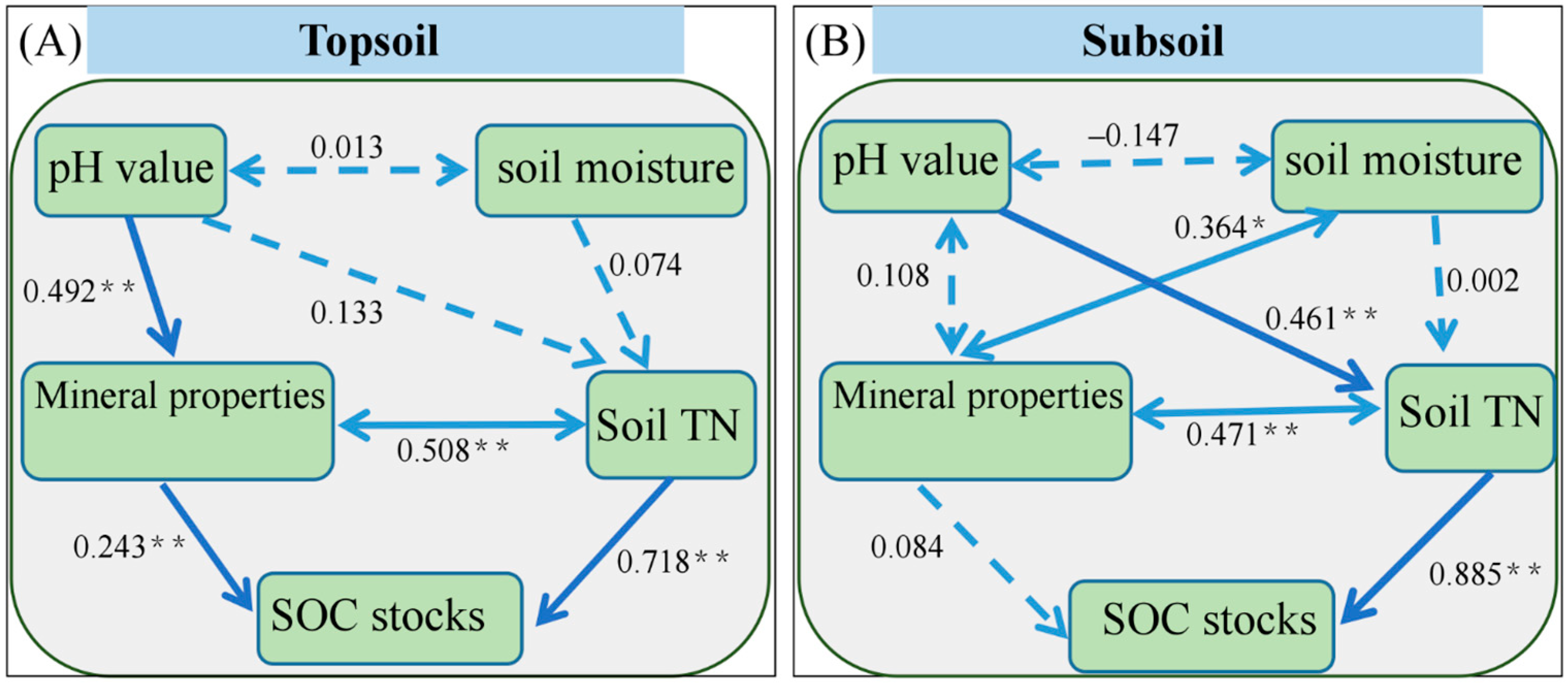
Disclaimer/Publisher’s Note: The statements, opinions and data contained in all publications are solely those of the individual author(s) and contributor(s) and not of MDPI and/or the editor(s). MDPI and/or the editor(s) disclaim responsibility for any injury to people or property resulting from any ideas, methods, instructions or products referred to in the content. |
© 2024 by the authors. Licensee MDPI, Basel, Switzerland. This article is an open access article distributed under the terms and conditions of the Creative Commons Attribution (CC BY) license (https://creativecommons.org/licenses/by/4.0/).
Share and Cite
Xu, Y.; Jiao, J.; Wu, C.; Zhao, Z.; Ge, X.; Gao, G.; Cao, Y.; Zhou, B. Abandonment Leads to Changes in Forest Structural and Soil Organic Carbon Stocks in Moso Bamboo Forests. Plants 2024, 13, 2301. https://doi.org/10.3390/plants13162301
Xu Y, Jiao J, Wu C, Zhao Z, Ge X, Gao G, Cao Y, Zhou B. Abandonment Leads to Changes in Forest Structural and Soil Organic Carbon Stocks in Moso Bamboo Forests. Plants. 2024; 13(16):2301. https://doi.org/10.3390/plants13162301
Chicago/Turabian StyleXu, Yaowen, Jiejie Jiao, Chuping Wu, Ziqing Zhao, Xiaogai Ge, Ge Gao, Yonghui Cao, and Benzhi Zhou. 2024. "Abandonment Leads to Changes in Forest Structural and Soil Organic Carbon Stocks in Moso Bamboo Forests" Plants 13, no. 16: 2301. https://doi.org/10.3390/plants13162301
APA StyleXu, Y., Jiao, J., Wu, C., Zhao, Z., Ge, X., Gao, G., Cao, Y., & Zhou, B. (2024). Abandonment Leads to Changes in Forest Structural and Soil Organic Carbon Stocks in Moso Bamboo Forests. Plants, 13(16), 2301. https://doi.org/10.3390/plants13162301






